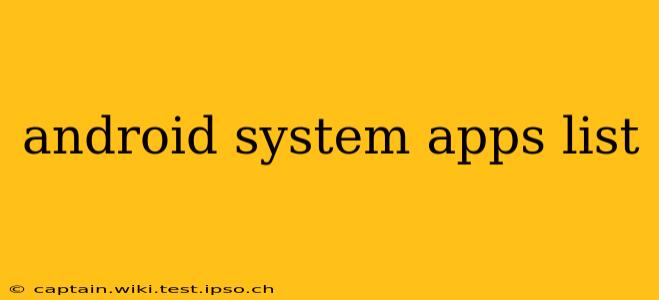Android's operating system comes pre-loaded with a suite of essential apps, often referred to as system apps. These apps are crucial for the basic functioning of your device and provide core functionalities. While the exact list might vary slightly depending on the Android version, manufacturer, and device model, we'll explore the common core system apps and their roles. Understanding these apps helps you better manage your device and troubleshoot potential problems.
What are Android System Apps?
Android system apps are pre-installed applications integrated directly into the Android operating system. They are essential for the device's core functionality and cannot be typically uninstalled (though some may be disabled). These apps handle everything from managing calls and messages to controlling network connectivity and providing security features.
Common Android System Apps and Their Functions
Here's a breakdown of some of the most common Android system apps you'll find on most devices:
1. Phone:
This is your default phone app for making and receiving calls. It manages your contact list, call history, and allows you to initiate calls via various methods.
2. Contacts:
This app stores and manages your contact information, allowing you to easily access and organize your contacts, both locally and potentially synced with online services like Google Contacts.
3. Messages:
This is the default SMS (text messaging) app, handling the sending and receiving of text messages. Many modern implementations also support richer messaging (MMS) allowing for sending images, videos, and other media.
4. Settings:
The Settings app is your central control panel for customizing virtually every aspect of your Android device. From Wi-Fi and Bluetooth to display settings, app permissions, and account management, the Settings app is where you manage your phone's configuration.
5. Email:
This app handles email accounts, allowing you to manage multiple accounts from different providers. It typically supports POP3, IMAP, and SMTP protocols.
6. Camera:
The Camera app provides access to your device's camera functionalities. It varies greatly depending on the manufacturer and device, but typically includes basic settings for image capture and video recording.
7. Gallery:
The Gallery app allows you to view and manage photos and videos stored on your device. It often incorporates features like photo organization, editing tools, and sharing options.
8. Calendar:
This app allows you to manage your schedules, create and edit events, and sync your calendar with online services.
9. Clock:
This app provides access to a clock, alarm, timer, and stopwatch functionality.
10. Downloads:
This app manages files downloaded from the internet and other sources. You can view, open, or delete downloaded files directly within this app.
What about other System Apps?
Many other system apps exist, performing specific functions. Examples include:
- Google Play Services: A crucial background service for Google apps and many third-party apps.
- Google Play Store: The official app store for Android apps. (Note: This is often considered a system app, even though it can be updated).
- Android System WebView: Allows apps to display web content within the app.
- Google Services Framework: Provides core functionalities for Google services.
These are just some examples; the specific system apps and their names can vary significantly across different devices and Android versions.
Can I Uninstall or Disable System Apps?
Generally, you cannot completely uninstall system apps. However, on many Android devices, you can disable them. Disabling a system app will remove it from your app drawer and prevent it from running in the background, but it might cause certain functionalities to cease working correctly. Proceed with caution when disabling system apps, as it's not recommended unless you fully understand the consequences.
Troubleshooting System App Issues
If you encounter issues with a system app, try these steps:
- Restart your device: A simple restart can often resolve temporary glitches.
- Check for updates: Ensure your device and apps are up-to-date.
- Clear cache and data: This can resolve conflicts within the app. (Be cautious; this may delete settings and data associated with the app).
- Factory reset: As a last resort, a factory reset can resolve more severe problems. This will erase all your data, so back up important information beforehand.
Understanding your Android system apps is vital for managing your device effectively and troubleshooting any problems that may arise. This guide provides a solid foundation for navigating the world of pre-installed applications and their importance in the overall Android experience.
